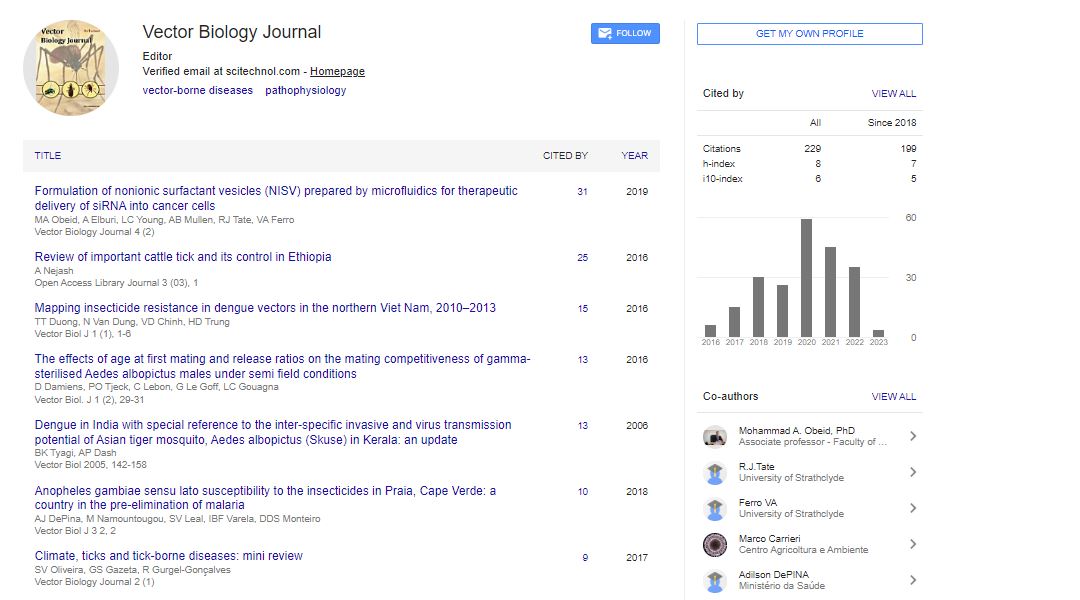Commentary, Vector Biol J Vol: 10 Issue: 1
Vectorial Capacity and the Mechanics of Vector-Borne Disease Spread
Robin Mark*
Department of Biology, Institute of Infectious Diseases, China
- *Corresponding Author:
- Robin Mark
Department of Biology, Institute of Infectious Diseases, China
E-mail: mark.ro@gmail.com
Received: 01-Mar-2025, Manuscript No. VBJ-22-169496, Editor assigned: 03-Mar-2025, PreQC No. VBJ-22-169496(PQ), Reviewed: 17-Mar-2025, QC No. VBJ-22-169496, Revised: 21-Mar-2025, Manuscript No. VBJ-22- 169496(R), Published: 28-Mar-2025, DOI: 10.4172/2473-4810.1000337
Citation: Robin M (2025) Vectorial Capacity and the Mechanics of Vector- Borne Disease Spread. Vector Biol J 10: 337
Copyright: © 2025 Robin M. This is an open-access article distributed under the terms of the Creative Commons Attribution License, which permits unrestricted use, distribution and reproduction in any medium, provided the original author and source are credited.
Abstract
Vectorial capacity is a fundamental concept in vector biology that
quantifies the potential of a vector population to transmit a pathogen
to susceptible hosts. Unlike simple vector presence, vectorial capacity
incorporates multiple biological and environmental variables to
provide a dynamic estimate of disease transmission risk. It plays
a pivotal role in understanding the epidemiology of mosquito-borne
diseases such as malaria, dengue, and yellow fever. By assessing
parameters like biting rate, vector lifespan, and pathogen development
time, public health programs can evaluate outbreak potential and
guide intervention strategies.
Keywords: Vectorial capacity, Vector competence, Vector-borne diseases, Disease transmission dynamics, Epidemiology of vectors
Introduction
Vectorial capacity is a fundamental concept in vector biology that quantifies the potential of a vector population to transmit a pathogen to susceptible hosts. Unlike simple vector presence, vectorial capacity incorporates multiple biological and environmental variables to provide a dynamic estimate of disease transmission risk [1]. It plays a pivotal role in understanding the epidemiology of mosquito-borne diseases such as malaria, dengue, and yellow fever. By assessing parameters like biting rate, vector lifespan, and pathogen development time, public health programs can evaluate outbreak potential and guide intervention strategies [2].
Description
Temperature significantly influences vectorial capacity. Warmer climates accelerate the pathogenâ??s incubation inside the mosquito, reducing the time required before the vector becomes infectious. However, excessively high temperatures can reduce mosquito lifespan, thereby decreasing vectorial capacity. Rainfall and humidity also affect mosquito survival and breeding, which, in turn, influence density and biting behavior [4].
Another critical factor is the anthropophilic nature of the vector species. Species that prefer human hosts, such as Aedes aegypti, are more likely to facilitate disease outbreaks than zoophilic species. Host availability, immune status, and local housing conditions also contribute to effective vector-host contact, further shaping the transmission landscape [5].
Discussion
Understanding vectorial capacity helps predict regions at risk for disease outbreaks and supports evidence-based public health planning. For instance, areas with high mosquito density, rapid biting cycles, and prolonged vector survival are considered high transmission zones. In such regions, vector control becomes a critical intervention.
Several real-world applications of vectorial capacity models exist. In Sub-Saharan Africa, high values of C have led to targeted malaria control programs, including insecticide-treated nets (ITNs), indoor residual spraying (IRS), and larval source management. Similarly, predictive modeling has been used to estimate dengue risk in Latin America and Southeast Asia, accounting for seasonal climate patterns and urbanization [2].
Vectorial capacity models have limitations. The traditional formula assumes homogeneity in mosquito behavior and host distribution, which may not reflect reality. For example, mosquito biting behavior can vary with time, age, and infection status. Additionally, urban environments introduce spatial clustering of humans and breeding sites, leading to heterogeneous exposure [3]. Recent models attempt to integrate such complexities using spatial statistics and stochastic simulations.
Technological advances like Geographic Information Systems (GIS), remote sensing, and climate modeling have significantly improved the estimation and application of vectorial capacity. Satellite-derived environmental data are now used to create high-resolution maps that overlay vector density, rainfall, temperature, and vegetation indices. These tools enable real-time surveillance and dynamic risk mapping for targeted intervention [4].
Moreover, integrating vectorial capacity with other epidemiological indicators such as the basic reproduction number (Râ??), entomological inoculation rate (EIR), and vector competence offers a comprehensive understanding of disease ecology. This integration is particularly valuable in evaluating the impact of new interventions like genetically modified mosquitoes and Wolbachia-based suppression programs [5].
Conclusion
Vectorial capacity is a powerful conceptual and analytical framework that encapsulates the biological and ecological complexity of vector-borne disease transmission. It provides actionable insights into how changes in vector behavior, environmental conditions, and intervention strategies influence transmission risk. Despite its limitations, it remains a cornerstone of vector biology and public health. As data collection and modeling techniques continue to evolve, vectorial capacity will play an even more critical role in predicting disease dynamics and guiding control programs in diverse epidemiological settings.
References
- Stephansson O, Falconer H, Ludvigsson JF (2011) Risk of endometriosis in 11,000 women with celiac disease. Hum Reprod26: 2896-2901.
- Selam B, Kayisli UA, Garcia-Velasco JA, Arici A (2002) Extracellular matrix-dependent regulation of Fas ligand expression in human endometrial stromal cells. Biol Reprod 66: 1-5.
- Sampson JA (1927)Peritoneal endometriosis due to the menstrual dissemination of endometrial tissue into the peritoneal cavity. Am J Obstet Gynecol14: 422â??469.
- Poppe K, Velkeniers B (2003) Thyroid disorders in infertile women. Ann Endocrinol 64: 45-50.
- May KE, Conduit-Hulbert SA, Villar J, Kirtley S, Kennedy SH, et al. (2010) Peripheral biomarkers of endometriosis: a systematic review. Hum Reprod Update16: 651â??674.
Indexed at, Google Scholar, Crossref
Indexed at, Google Scholar, Crossref
 Spanish
Spanish  Chinese
Chinese  Russian
Russian  German
German  French
French  Japanese
Japanese  Portuguese
Portuguese  Hindi
Hindi 